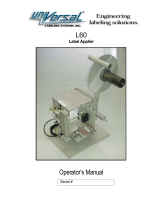
2 3
1 Introduction ............................................................................................................................................ 4
1.1 Instructions ...............................................................................................................................................4
1.2 Intended Use ............................................................................................................................................4
1.3 Safety Instructions ....................................................................................................................................4
1.4 Safety Markings .......................................................................................................................................5
1.5 Environment .............................................................................................................................................5
2 Product Description ...............................................................................................................................6
2.1 Important Features ...................................................................................................................................6
2.2 Technical Data ..........................................................................................................................................6
2.3 Overview .................................................................................................................................................. 7
2.4 Contents of Delivery .................................................................................................................................8
3 Mounting .................................................................................................................................................9
4 Settings .................................................................................................................................................10
4.1 Adjusting the Air-Jet Module ..................................................................................................................10
4.2 Vacuum Adjustments ..............................................................................................................................12
4.3 Adjusting the Blow Tube (Supporting Air) ...............................................................................................13
4.4 CongurationParametersoftheApplicator ...........................................................................................13
5 External Start-Sensor ..........................................................................................................................14
5.1 Connection .............................................................................................................................................14
5.2 Signals ...................................................................................................................................................14
6 Operation .............................................................................................................................................. 15
6.1 Standard Operation ................................................................................................................................15
6.2 Cleaning .................................................................................................................................................15
6.3 Sizing the Former Plate ..........................................................................................................................16
7 Error Messages .................................................................................................................................... 17
7.1 Error Messages of the Printer ................................................................................................................ 17
7.2 Error messages of the Air-Jet Box .........................................................................................................17
8 Licences ................................................................................................................................................18
8.1 Declaration of Incorporation ...................................................................................................................18
8.2 EU Declaration of Conformity .................................................................................................................19
Table of Contents





















